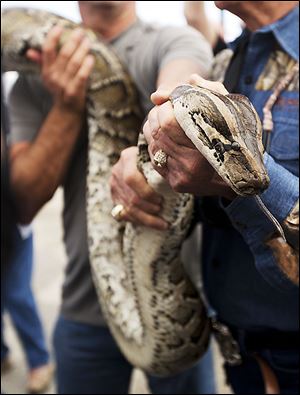
Pythons attract bounty hunters to Florida
1/19/2013
A captured 13-foot-long Burmese python is displayed for hunters before starting the Python Challenge.
OCHOPEE, Fla. — A year ago, on a visit to the Big Cypress National Preserve here and to the Everglades National Park to the south, it was evident the biologists and other officials in charge of protecting these treasured lands were discouraged, frustrated, and exhausted.
They were losing their tedious battle with the invasive python snakes that have been destroying much of the native wildlife in this vast, watery area on the southern tip of the Sunshine State.
What I sensed then was a feeling of helplessness as the stewards of the Everglades struggled to confront an enemy that threatened to do irreparable damage to the fragile ecosystem.
Now, in a sign of creative desperation, they have called out the infantry.
An old-fashioned bounty hunt is under way, sending a posse of professional hunters and weekend warriors into the grassy wetlands and the cypress forests, in search of the exotic snakes.
They are calling it “The 2013 Python Challenge,” a month-long competition with the intention of removing as many of the powerful constrictors as possible.
There is $5,000 in prize money on the line, put together through donations and a registration fee paid by each participant. Bring in the most Burmese pythons and you take home $1,500. Take the largest python during the event, and the prize is $1,000.
The Florida Wildlife Commission organized the hunt, and its director Kenneth Wright called it “an unprecedented effort . . . to help deal with Burmese pythons.”
More than 1,100 snake hunters have already signed up, taken the on-line training and put down $25 to take part in the hunt.
As of Friday, the group had harvested 21 pythons.
“We are pleased that so many people are joining this earnest effort to limit the impact of this invasive species on Florida’s diverse native wildlife,” Wright said. “Floridians and people from all across the United States truly care about the Florida Everglades, and they are clearly eager to help us better understand and solve this problem.”
There are hunters from more than 30 states taking part in the project, and it makes sense for an army of the people to volunteer to help in the crusade, since the python problem has man’s fingerprints all over it.
The only plausible explanations for how these pythons ended up in the Everglades is that they were pets that were dumped in canals or rural areas, and then found their way to the huge swampland . . . or they escaped captivity from improperly secured enclosures during hurricanes.
If you turn a pet python loose in Ohio, the first hard frost likely ends its life. That’s not the case in the largest subtropical wilderness in the country — turn a python loose here in the Everglades, and it has an ideal climate for breeding, millions of places to hide, plenty of food sources, and no natural predators.
“Because of our climate here, there is an opportunity for these non-native species to get a foothold,” said Carli Segelson of the Florida Wildlife Commission.
Since Everglades National Park proper does not allow public hunting, the python bounty hunt will take place in the rest of the Everglades region, including here in Big Cypress, and in three other wildlife management areas.
Kristen Sommers of the Florida Wildlife Commission’s Exotic Species Coordination Section said utilizing a civilian militia of snake hunters makes sense on several levels.
Besides removing a number of the large snakes from the delicate environment, she hopes news of the bounty hunt will let the south Florida populace know where this problem likely has its origin.
“Part of our goal is to educate the public to understand why non-native species like Burmese pythons should never be released into the wild,” Sommers said.
“We really want to raise the awareness about invasive species and the impact they have on our wildlife,” Segelson asserted.
The marauding pythons have nearly wiped out native populations of mammals in some areas, and captured pythons have been found to have ingested bobcats, deer, and even alligators. A recent study showed that populations of raccoons, opossums, and white-tailed deer in the Everglades had decreased by 90 percent over the last two decades.
Pythons are a more serious threat to the bird population in the Everglades, including a number of rare or endangered species of birds.
Hunters are expected to fan out daily across sections of the vast Everglades sawgrass prairie and cypress swamp until the competition ends on Feb. 10. Wildlife biologists readily admit they have no real idea how many pythons are there, but they estimate the number at between tens of thousands and more than 100,000.
The bounty hunters are encouraged to use humane methods to harvest the pythons, and are discouraged from eating the meat. Burmese pythons removed from the Everglades National Park in the past have been found to contain high levels of mercury and therefore deemed unsafe for consumption by humans.
It is now illegal to import pythons and numerous other exotic animals into Florida, or transport them there. Segelson said the state is also using the platform it has with the bounty hunt to promote an amnesty program that allows owners of exotic pets to turn them in with no questions asked, and allow rescue groups to find the animals new homes.
“It is the responsible thing to do for the environment,” she said. “And the responsible thing to do for your pet.”
More than 600 exotics were turned in under the amnesty program in 2012, including a coatimundi, a Sulcata tortoise, an African pygmy hedgehog, along with monitors, boas, pythons, and corn snakes.
Contact Blade outdoors editorMatt Markey at:mmarkey@theblade.comor 419-724-6068.